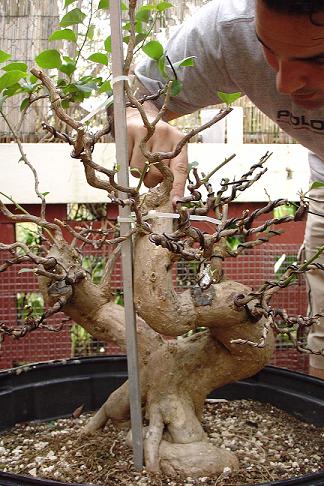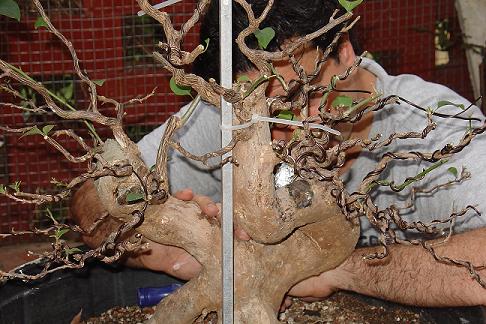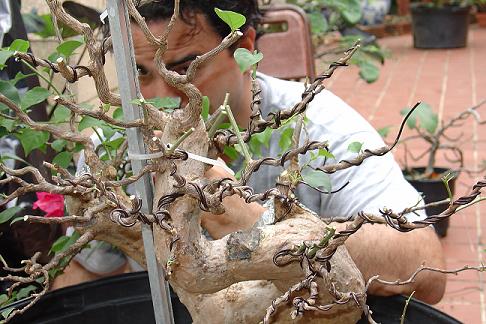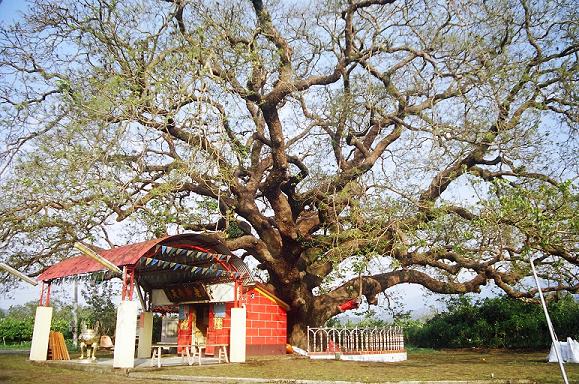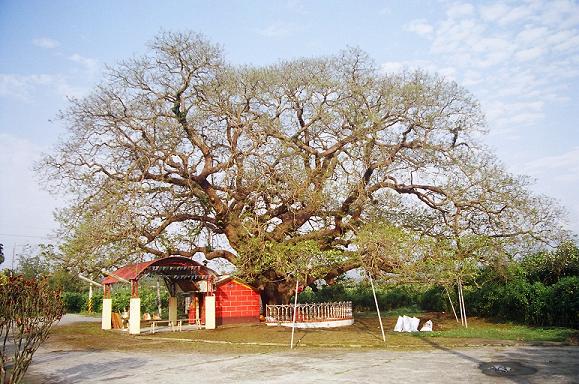Bougainvillea Glabra
+4
Budi Sulistyo
Joe Alansalon
Rob Kempinski
jrodriguez
8 posters
Page 1 of 1

jrodriguez- Member
 Re: Bougainvillea Glabra
Re: Bougainvillea Glabra
Hey Jose, Wlecome back to the forum.
That is the way to be patient - 15 years in the ground in Puerto Rico is practically a life time for a temperate tree.
Wiring bougy brnaches - you are very patient indeed. I don't keep too many bougies but use almost exclusively clip and grow on the couple I do have. However, I admit I don't really like nor fully understand bougy bonsai. They do look nice when in color.
Got anything interesting growing? I'm coming to PR in July. The Lime Berry is doing well but growing very slowly.
That is the way to be patient - 15 years in the ground in Puerto Rico is practically a life time for a temperate tree.
Wiring bougy brnaches - you are very patient indeed. I don't keep too many bougies but use almost exclusively clip and grow on the couple I do have. However, I admit I don't really like nor fully understand bougy bonsai. They do look nice when in color.
Got anything interesting growing? I'm coming to PR in July. The Lime Berry is doing well but growing very slowly.

Rob Kempinski- Member
 Re: Bougainvillea Glabra
Re: Bougainvillea Glabra
Rob,
Yes, wiring their branches is a pain and requires almost tantrical concentration. Please do note the metal bar. Given the fact that bougainvilleas are vines, supporting the branches that you want to thicken with foraneous objects helps a lot.
Currently, i am growing Tamarind, Clerodendron, Malpighia and several other species.
Your triphasia should do fine. Here they grow quite fast. What type of soil are you currently using for it?
Kind Regards,
Jose Luis
Yes, wiring their branches is a pain and requires almost tantrical concentration. Please do note the metal bar. Given the fact that bougainvilleas are vines, supporting the branches that you want to thicken with foraneous objects helps a lot.
Currently, i am growing Tamarind, Clerodendron, Malpighia and several other species.
Your triphasia should do fine. Here they grow quite fast. What type of soil are you currently using for it?
Kind Regards,
Jose Luis

jrodriguez- Member
 Re: Bougainvillea Glabra
Re: Bougainvillea Glabra
Wow, nice to see a potentially beautiful bougy bonsai especially when it blooms.
So, this 15 years old material plus a total of at least 6years of training will produce
a 21years old beautiful flowering bonsai. Truly, a show of patience.
Congrats for having such material.
Joe
So, this 15 years old material plus a total of at least 6years of training will produce
a 21years old beautiful flowering bonsai. Truly, a show of patience.
Congrats for having such material.
Joe
Joe Alansalon- Member
 Re: Bougainvillea Glabra
Re: Bougainvillea Glabra
Jose Luis,
The material is really fantastic. I am sure that it will become a very beautiful bougi in the future. Congratulations.
Your friend,
Budi
.
The material is really fantastic. I am sure that it will become a very beautiful bougi in the future. Congratulations.
Your friend,
Budi
.
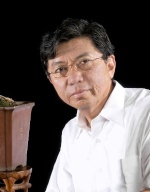
Budi Sulistyo- Member
 Re: Bougainvillea Glabra
Re: Bougainvillea Glabra
Joe and Budi,
Bougainvillea has somewhat been neglected as bonsai material in the west. Also, if when one gets a chance to see a bougainvillea bonsai, most of the time it's just a stump with spectacular flowers, not a quality tree.
In southern Taiwan, particularly in Tainan, Kaohshiung and Pindong, it is quite common to see great bougainvillea bonsai. Per the information included in the invitation to the 10th ASPAC in Taiwan, the Taiwan Fruit and Flower Bonsai Association will make its mark in this event. I believe that great trees will be exhibited and i urge everyone to attend this event, particularly those interested in growing tropical bonsai.
Budi, we will have lots of fun in Taiwan. Joe, try and attend the event.
Rob, are you going?
Your friend,
Jose Luis
Bougainvillea has somewhat been neglected as bonsai material in the west. Also, if when one gets a chance to see a bougainvillea bonsai, most of the time it's just a stump with spectacular flowers, not a quality tree.
In southern Taiwan, particularly in Tainan, Kaohshiung and Pindong, it is quite common to see great bougainvillea bonsai. Per the information included in the invitation to the 10th ASPAC in Taiwan, the Taiwan Fruit and Flower Bonsai Association will make its mark in this event. I believe that great trees will be exhibited and i urge everyone to attend this event, particularly those interested in growing tropical bonsai.
Budi, we will have lots of fun in Taiwan. Joe, try and attend the event.
Rob, are you going?
Your friend,
Jose Luis

jrodriguez- Member
 Re: Bougainvillea Glabra
Re: Bougainvillea Glabra
Jose,
Well done, Congratulation.
Dear all,
Welcome to participate 10th ASPAC http://aspac2009.tw/ to ENJOY TAIWAN this Oct.
Over 500 masterpiece bonsai & 300 suiseki will attend the exhibition. You will smell somthing fresh.
Well done, Congratulation.
Dear all,
Welcome to participate 10th ASPAC http://aspac2009.tw/ to ENJOY TAIWAN this Oct.
Over 500 masterpiece bonsai & 300 suiseki will attend the exhibition. You will smell somthing fresh.

bontailo- Member
 Re: Bougainvillea Glabra
Re: Bougainvillea Glabra
Jose Luis,
It is good to design your tree inspired by natural shapes in nature. It could be of different species.
Your friend,
Budi
It is good to design your tree inspired by natural shapes in nature. It could be of different species.
Your friend,
Budi

Budi Sulistyo- Member
 Re: Bougainvillea Glabra
Re: Bougainvillea Glabra
Budi,
Your comments are right on point. I use different model depending on the tree species. For example, shaping a pemphis or a buttonwood this way, although interesting, will be a little strange.
Your friend,
Jose Luis
Your comments are right on point. I use different model depending on the tree species. For example, shaping a pemphis or a buttonwood this way, although interesting, will be a little strange.
Your friend,
Jose Luis

jrodriguez- Member
 Re: Bougainvillea Glabra
Re: Bougainvillea Glabra
We will be attending the 10th ASPAC in Taiwan as a group.
Joe Alansalon- Member
 Re: Bougainvillea Glabra
Re: Bougainvillea Glabra
Jose-
Could you show pics of your tamarind? One of my friends just gave me a seedling.
-PT
Could you show pics of your tamarind? One of my friends just gave me a seedling.
-PT

prestontolbert- Member
 Bougainvillea Glabra
Bougainvillea Glabra
Hi
Is this bougainvllea glabra the same as our specie here we lacally call 21 jewels? are the flowers violet and the leaves are thicker and smaller than the ordinary bougainvillea?
Pabling
Is this bougainvllea glabra the same as our specie here we lacally call 21 jewels? are the flowers violet and the leaves are thicker and smaller than the ordinary bougainvillea?
Pabling

Ka Pabling- Member
 Re: Bougainvillea Glabra
Re: Bougainvillea Glabra
Pady,
No, this is not the 21 jewels. This is regular bougainvillea. Although 21 jewels is smaller, this one reduces even further.
Kind regards,
Jose Luis
No, this is not the 21 jewels. This is regular bougainvillea. Although 21 jewels is smaller, this one reduces even further.
Kind regards,
Jose Luis

jrodriguez- Member
 Re: Bougainvillea Glabra
Re: Bougainvillea Glabra
Hi Jose,
thanks for sharing. I see that you defoliated the tree almost completely. Do you do this so that the leaves do not impede you from using the wire or to decrease the leaf size? When do you defoliate?
Thanks again.
Cosmos
thanks for sharing. I see that you defoliated the tree almost completely. Do you do this so that the leaves do not impede you from using the wire or to decrease the leaf size? When do you defoliate?
Thanks again.
Cosmos
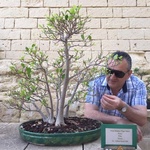
cosmos- Member
 Re: Bougainvillea Glabra
Re: Bougainvillea Glabra
Cosmos,
Bougainvillea bonsai must be developed periodically. In my hot and humid weather, the tree needs constant wiring and pruning to keep it in shape. This tree was cut back at the time i posted this thread to encourage the bottom branches to grow further. Right now, all branches have developed new terminals and all leaves that grow down to the stem were and are constantly removed. This technique helps you promote apical growth, thus making it possible for the branches to thicken. As this species is a vine and thus a top grower, a different approach must be used. In the Puertorican, Indonesian and Taiwanese summers, the humid and hot climate obliges us to work on bougainvilleas every two weeks. If a typhoon or hurricane approaches and we have several days of overlapping rain and sun, they grow even faster. This is a problem, as wire begins to cut in the branches before they have time to set. As this dilema has also a solution, I try to wire branches when they are quite tender.
If you take a close look at this specimen, both trunks have been cut to size and new leaders have grown from this point. As i hate dead wood on bouigainvillea and think it is quite unsightly and artificial, the new leaders are left alone until they cover the cut sight completely. Even if you treat deadwood on these trees, one of two things will happen: 1) the live part will detach itself as it matures or; 2) the wood will eventually rot. To impede the rotting of the cut sites, i protect them with concrete. When the new leads begin to thicken, they will grow over the concrete and completely cover the unsightly cuts ( i began using this technique when i saw a huge tree that grew through a fence and its branches swallowed the concrete). I also used concrete to protect large cuts in ficus. Given the fact that ficus wood is also soft and tends to rot, i use concrete to stabilize the cut area and promote healing. Tissue from cut sites needs surface ground to grow over, so i always discourage hollowing out the cut sites. On a later date i will post a couple of pictures of this for the benefit and imput of all the forum members.
As this tree is still in development, no leaf reduction will be issued. I need the largest, healthiest leaves possible to help me thicken the branches and promote taper. Right now the tree has only two generations present, being the trunk the grandfather and the branches the great-grandsons. By periodicaly building the branch structure, i will fill in the generational gaps (Grandfather, Father, Son, grandson, etc..). Building taper in bougainvillea is quite a challenge as cut sites rarely or never callus. To solve this problem, an oversized container or a growth bed is used. Since the tree has a lot of room to grow, multiple branches will develop from the cuts. Once you select the new lead and wire it to position, it will be left alone to grow and the whole process is repeated again. By periodically buiding the ramification outward, two goals are achieved: 1) perfectly tapered branches and 2) a well balanced tree with no single cuts.
Creating a 'fast' or 'instant' bonsai is quite easy and will bring reward to the creator. I belive that the most important element in bonsai creation relies on the branch structure. As these are constantly fighting with the elements, the true story of a tree can be learned through their study.
I hope my attempt to explain my technique is clear. I apologize if i left any gaps in my explanation.
I ALMOST FORGOT; PLEASE ATTENT THE 10th ASPAC IN TAIWAN!!!
Kind regards,
Jose Luis
Bougainvillea bonsai must be developed periodically. In my hot and humid weather, the tree needs constant wiring and pruning to keep it in shape. This tree was cut back at the time i posted this thread to encourage the bottom branches to grow further. Right now, all branches have developed new terminals and all leaves that grow down to the stem were and are constantly removed. This technique helps you promote apical growth, thus making it possible for the branches to thicken. As this species is a vine and thus a top grower, a different approach must be used. In the Puertorican, Indonesian and Taiwanese summers, the humid and hot climate obliges us to work on bougainvilleas every two weeks. If a typhoon or hurricane approaches and we have several days of overlapping rain and sun, they grow even faster. This is a problem, as wire begins to cut in the branches before they have time to set. As this dilema has also a solution, I try to wire branches when they are quite tender.
If you take a close look at this specimen, both trunks have been cut to size and new leaders have grown from this point. As i hate dead wood on bouigainvillea and think it is quite unsightly and artificial, the new leaders are left alone until they cover the cut sight completely. Even if you treat deadwood on these trees, one of two things will happen: 1) the live part will detach itself as it matures or; 2) the wood will eventually rot. To impede the rotting of the cut sites, i protect them with concrete. When the new leads begin to thicken, they will grow over the concrete and completely cover the unsightly cuts ( i began using this technique when i saw a huge tree that grew through a fence and its branches swallowed the concrete). I also used concrete to protect large cuts in ficus. Given the fact that ficus wood is also soft and tends to rot, i use concrete to stabilize the cut area and promote healing. Tissue from cut sites needs surface ground to grow over, so i always discourage hollowing out the cut sites. On a later date i will post a couple of pictures of this for the benefit and imput of all the forum members.
As this tree is still in development, no leaf reduction will be issued. I need the largest, healthiest leaves possible to help me thicken the branches and promote taper. Right now the tree has only two generations present, being the trunk the grandfather and the branches the great-grandsons. By periodicaly building the branch structure, i will fill in the generational gaps (Grandfather, Father, Son, grandson, etc..). Building taper in bougainvillea is quite a challenge as cut sites rarely or never callus. To solve this problem, an oversized container or a growth bed is used. Since the tree has a lot of room to grow, multiple branches will develop from the cuts. Once you select the new lead and wire it to position, it will be left alone to grow and the whole process is repeated again. By periodically buiding the ramification outward, two goals are achieved: 1) perfectly tapered branches and 2) a well balanced tree with no single cuts.
Creating a 'fast' or 'instant' bonsai is quite easy and will bring reward to the creator. I belive that the most important element in bonsai creation relies on the branch structure. As these are constantly fighting with the elements, the true story of a tree can be learned through their study.
I hope my attempt to explain my technique is clear. I apologize if i left any gaps in my explanation.
I ALMOST FORGOT; PLEASE ATTENT THE 10th ASPAC IN TAIWAN!!!
Kind regards,
Jose Luis

jrodriguez- Member
 Similar topics
Similar topics» Some summer work on a large bougainvillea glabra
» Pachira glabra
» Malpighia Glabra
» Acerola (Malpighia glabra)
» Bougaivillia glabra "leaning fat lady"
» Pachira glabra
» Malpighia Glabra
» Acerola (Malpighia glabra)
» Bougaivillia glabra "leaning fat lady"
Page 1 of 1
Permissions in this forum:
You cannot reply to topics in this forum








